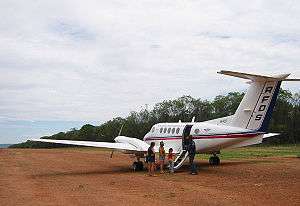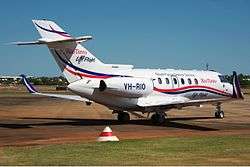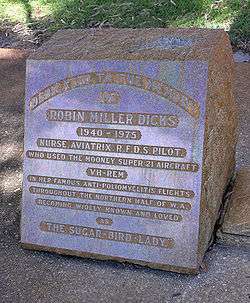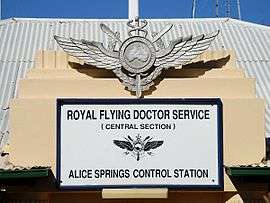Royal Flying Doctor Service of Australia
|
Old RFDS logo at Alice Springs Base | |
| Abbreviation | RFDS |
|---|---|
| Predecessor | AIM Aerial Medical Service |
| Founder | Rev. John Flynn |
| Founded at | Cloncurry, Queensland |
| Type | Not-for-profit organisation |
| Legal status | Charity |
| Purpose | To provide excellence in aeromedical and primary health care across Australia |
Region | Australia |
| Services | Air ambulance |
Official language | English |
| Slogan | The Flying Doctor |
| Website |
flyingdoctor |


The Royal Flying Doctor Service of Australia (RFDS, informally known as The Flying Doctor) is one of the largest and most comprehensive aeromedical organisations in the world. It provides emergency and primary health care services for those living in rural, remote and regional areas of Australia. It is a not-for-profit organisation which provides health care to people who cannot access a hospital or general practice due to the vast distances of the Outback.
History
A "mantle of safety" for the outback
The Reverend John Flynn had worked in rural and remote areas of Victoria and was commissioned by the Presbyterian Church to look at the needs of Outback people. His report to the Presbyterian Assembly in 1912 resulted in the establishment of the Australian Inland Mission (AIM), of which he was appointed Superintendent. In 1928, he formed the AIM Aerial Medical Service, a one-year experiment based in Cloncurry, Queensland. This experiment later became The Royal Flying Doctor Service.
Flynn's missionary work involved the establishment of hospitals in bush communities. This, however, did not help those who lived far from any major community. In his public speaking he would often retell the tragic circumstances that had befallen several bush settlers. The fate of Jimmy Darcy, in 1917, was one of these stories.
- Darcy was a stockman at Ruby Plains, a remote cattle station in Western Australia. After being found injured, with a ruptured bladder, by some friends, he was transported over 30 miles (12 hours), to the nearest town, Halls Creek. Here, Darcy was met by FW Tuckett, the Postmaster, and the only man in the settlement trained in first aid. Tuckett said there was nothing he could reliably do for injuries so serious, and tried unsuccessfully to contact doctors at Wyndham, and then Derby, by telegraph. He eventually got through to a doctor in Perth. Through communication by morse code, Dr Holland guided Tuckett through two rather messy bladder operations using the only sharp instrument available, a pen knife. Due to the total absence of any medical facilities, Darcy had been operated on strapped to the Post Office counter, having first been made insensible with whisky. Holland then travelled 10 days to Halls Creek on a boat for cattle transport, a Model T Ford, a horse-drawn carriage, and even on foot, only to find that Darcy had died the day before. To rub salt in the wound, the operations had been successful, but the stockman had died from an undiagnosed case of malaria and a ruptured abscess in his appendix.
It was from stories such as this that Flynn, and his following at the AIM, became inspired to develop a route of communications that could solve the problem of remoteness. However, no feasible technology seemed apparent.
Flight and radio: the fusion of two fledgling technologies
Victorian pilot Lieutenant Clifford Peel had heard Flynn's public speeches, and on being shipped out to France for World War I in 1917, sent Flynn a letter explaining how he had seen a missionary doctor visiting isolated patients using a plane. Assisted by costing estimates by Peel, Flynn immediately took the idea of using aircraft to begin his idea, and published Peel's idea in the church's newsletter. Peel died in combat in 1918, probably not even knowing the impact he had in the creation of an Australian icon.[1]
Along with motorised flight, another new technology was being developed that could replace the complicated means of communication by telegraph. Together with Alfred Traeger, Flynn began experiments with radio in the mid-1920s to enable remote outposts to contact a centralised medical base. The pedal radio was the first result of this collaboration. These were distributed gradually to stations, missions and other human residences around Cloncurry, the base site for a 50-watt transmitter.
By 1928, Flynn had gathered sufficient funds through fundraising activities to launch the experiment of the AMS on 15 May. Its supporters included industrialist HV McKay, medical doctor George Simpson, and Hudson Fysh, one of the founders of Queensland and Northern Territory Aerial Services, the company which would go on to become Qantas. Qantas supplied the first aircraft to the fledgling organisation, VH-UER a De Havilland DH.50, dubbed "Victory". On 17 May 1928,[2] two days after inception, the service's first official flight piloted by Arthur Affleck departed from Cloncurry, 85 miles to Julia Creek in Central Queensland, where the plane was met by over 100 people at the airstrip. Qantas charged two shillings per mile for use of the Victory during the first year of the project.[2]
Success, and continued success

Within the first year of operations, the service flew approximately 20,000 miles in 50 flights, becoming the first comprehensive air ambulance service in the world. The service persisted through some very tough first few years, dealing with postwar Australia and the Great Depression of the 1930s. During its first few decades the service relied heavily on community fundraising, volunteer support and donations. Nowadays, the service is supported by the Commonwealth, State and Territory Governments, but still relies heavily on fundraising and donations from the community to purchase and medically equip its aircraft, and to finance other major capital initiatives. Until the 1960s the service predominantly hired aircraft, pilots and service technicians from contractors. After this point, the service moved on to purchasing its own equipment and employing its own pilots and mechanics.
In 1932, the success from its operations in Cloncurry, and the increasing public awareness to this quite vital rural service, resulted in a push for a national network of flying doctors, hopefully with sponsorship from the government. In 1934 this was realised with the new Australian Aerial Medical Service opening up "Sections" across the nation. Bases were set up in Wyndham, Port Hedland, Kalgoorlie, Broken Hill, Alice Springs and Meekatharra. The Queensland experiment was expanded with two additional bases opening in Charters Towers and Charleville. An official Federal Council for the organisation was formed in 1936. In 1942 it was again renamed to Flying Doctor Service, with Royal being bestowed upon the service in 1955. On 22 October 1958, Holden car manufacturers donated their 500,000th vehicle to the service in Melbourne
Sister Myra Blanch was one of the first nurses, known as "Flying Sisters", to join the service. She was key in the New South Wales Section operations during the 1940s and 50s, even though Flying Nurses didn't actually become regular until the 1960s and now around 60% of patient transports are conducted with an RFDS nurse and pilot only on board. Nurses have been responsible for two innovations to the service, the "medical chest"[3] (1942), which was later to incorporate the RFDS official "body chart" (1951). The chart is an anatomical representation of a human being, with areas clearly numbered. With such a chart on the scene of a situation, a remote doctor can ask the patient "which number is the pain felt?" and receive an easily comprehensible reply. The medicines contained within the chest are similarly numbered for ease in the communications of specific medical instructions.
The service today

The service is still heavily reliant on community support for funding, and is well respected across the country as an organisation that has contributed much to rural, regional and remote communities.
Its services include:[4]
- Emergency – primary response to accident or illness
- Emergency evacuation, air ambulance services
- Telehealth – 24 hours per day, 7 days per week telephone and radio medical consultation services
- Primary health care clinics – the transportation of a general practitioner for regular clinical visits to remote areas (often a circuit visiting several communities and/or stations). Clinics include general practice, nursing services, child and maternal health, Aboriginal and Torres Strait Islander health, Rural Women's GP Service, mental health, dental services, allied health and medical specialists.
- Consultation, communication, and support for rural and remote doctors across Australia
- Inter-hospital transfer of patients
- Education and training opportunities and midwifery scholarships[5]
The service also uses not just aircraft but also four-wheel drives and other utility land vehicles to aid in transportation and communications.
Organisation

_Pilatus_PC-12-45_at_Wagga_Wagga_Airport.jpg)
The RFDS is made up of seven legal entities – National Office, Central Operations, Queensland Section, South Eastern Section, Tasmania, Victoria and Western Operations. The RFDS operates in a federated structure and each of the seven entities has its own Board and Management. Each entity operates independently, both financially and operationally.
The Flying Doctor operates from numerous bases, health services and other facilities (including marketing, fundraising and public relations as well as the national office) across Australia.[6]
RFDS Bases are operated by:
- Central Operations – with bases at Adelaide Airport, Alice Springs Airport and Port Augusta Airport, and health services at Andamooka, Marla and Marree.[6]
- South Eastern Section – Broken Hill, New South Wales; Dubbo, New South Wales; Launceston, Tasmania; Essendon Airport; and Sydney Airport and Bankstown Airport in Sydney.
- Victoria Operations - bases across the state, including Richmond, Maffra, Essendon Airport; Mildura and Wangaratta. The Victorian Section office is in Richmond, an inner eastern suburb of Melbourne.
- Queensland Section – Brisbane Airport, Bundaberg Airport, Cairns International Airport, Charleville, Longreach, Mount Isa, Rockhampton and Townsville Airport
- Western Operations – Derby, Kalgoorlie, Meekatharra, Perth's Jandakot Airport, and Port Hedland. The Rio Tinto LifeFlight jet is located at Perth Airport.
Bases at Carnarvon, Geraldton and Wyndham have closed, while the original base at Cloncurry was moved to Mount Isa in 1965 and the early base at Charters Towers moved to Cairns in 1972. A new Western Operations Base is being developed at Broome.
Aircraft
The first aircraft operated by the "Aerial Medical Service" in 1928 was a de Havilland DH.50 hired from the fledgling Queensland and Northern Territory Aerial Service (Qantas). It was replaced in 1934 by a DH.83 Fox Moth.[2]
During the 1930s and 1940s the fleet consisted of a mix of de Havilland DH.50s, DH.83 Fox Moths, DH.84 Dragons, DH.104 Doves and the de Havilland Australia DHA-3 Drover.
From the 1950s to 1970s, the fleet included the Beechcraft Baron, Beechcraft Travel Air, Beechcraft Queen Air, Beechcraft Duke, Cessna 180, Cessna 182, Cessna 421, Piper Cherokee and Piper PA-31 Navajo.
Aircraft were provided by contractors until the 1960s. Subsequently, the RFDS owned its own aircraft and employed its own pilots and engineers.


In the 1970s and 1980s the RFDS base at Broken Hill operated the Australian-made GAF Nomad.
From the 1980s to 2000s, the fleet included the Cessna 404 and Cessna 441.
For a time in the mid-2000s the aeromedical evacuation aircraft used were either the Pilatus PC-12 or the Beechcraft King Air 200 series. The internal configuration of these two aircraft varies in the different RFDS sections. Typically they are configured with two rear-facing seats which look onto two stretchers. In some aircraft, one stretcher can be removed quickly and two seats slipped into place instead.
Both the PC-12 and King Air are pressurised and so can be used to safely transport patients who would not otherwise tolerate the decreased atmospheric pressures involved in non-pressurised aircraft. By flying at a lower altitude than usual, the internal cabin pressure can be maintained throughout the flight at sea level. This is important for patients critically sensitive to pressure changes.
In addition, pressurised aircraft can fly at a sufficiently high altitude to be above turbulent weather conditions. This is of great benefit in providing an environment safe for the patient and staff, and also limits complications of aeromedical transport such as motion sickness and exacerbation of injuries such as unstable fractures.
In October 2009 the standardisation on the two aircraft types ended when two Cessna 208B Grand Caravans and a Hawker 800XP[7] joined the fleet.
As of June 2015 the RFDS fleet numbers 66[8] (this figure does not include aircraft which will be decommissioned in 2015–16).
- 17 Beechcraft B200 King Air
- 13 Beechcraft B200C King Air
- 2 Beechcraft B200SE Super King Air
- 2 Beechcraft B300C King Air
- 2 Cessna 208B Grand Caravan
- 1 Hawker 800XP
- 32 Pilatus PC-12
The South Eastern Section operates 18 King Airs (9 B200, 7 B200C and 2 B300C); the Queensland Section operates 16 King Airs (8 B200, 6 B200C and 2 B200SE), 3 PC-12s and the 2 Grand Caravans; Western Operations operates 15 PC-12s and the Hawker 800XP; and Central Operations operates a PC-12 fleet numbering 14 aircraft.[8]
Early in 2014 Western Australian Operations ordered 3 Pilatus PC-24 Jet aircraft and an option for one more. The aircraft is expected to be certified by the Federal Aviation Administration and the European Aviation Safety Agency in 2017.[9]
Medical Retrieval Equipment
The RFDS uses a wide range of contemporary emergency medical equipment to provide aeromedical retrieval services. These include transport ventilators, critical care monitors, infusion devices, point-of-care testing, portable diagnostic ultrasound and a range of other splints and devices.[10]
Statistics

According to the RFDS National Office 2014/15 Annual Report[8] the service owns 66 aircraft, and operates 23 bases with 1,225 employees. Each day, on average, the service:
- travels 73,554 kilometres by air
- performs 211 landings
- has 800 patient contacts (includes patients at clinics, patient transports and telehealth)
- transports 177 patients (includes primary evacuations, inter-hospital transfer, transports from clinics, repatriations and road transports by Victoria Mobile Patient Care Service)
- conducts 254 telehealth sessions.
School of the Air
The School of the Air, which links outback students with centralised teachers, until recently used the same radio equipment as the RFDS. This has been surpassed with the availability of internet services.
Notable people
Notable people associated with the RFDS include:
- Arthur Affleck, first pilot
- Clyde Fenton, first doctor in the Northern Territory, also a pilot
- John Flynn, founder
- Wylie Gibbs, doctor
- Macarthur Job, pilot
- John Grieve Woods, doctor
Cultural references
- The RFDS was the subject of the TV drama series The Flying Doctors. The series followed the lives of an RFDS crew based in a fictional township called "Coopers Crossing" and the members of the local population that they served.[11]
- In the 1950s the RFDS featured in a BBC Radio series The Flying Doctor, which became well known for the catchphrase "Flying Doctor to Wollumboola Base". A television show of the same title based on this radio series and starring Richard Denning ran on the British ITV network for one season (1959–60).[12]
- At the closing of Charlie Drake's humorous song "My Boomerang Won't Come Back", it is implied that the narrator accidentally downs a Flying Doctor plane with his boomerang.
- The Royal Flying Doctor Service of Australia is featured in the outback map of the video game Flight Control.[13]
- The British space rock group Hawklords released a song called "Flying Doctor" on their album 25 Years On (1978). It describes an Australian flying doctor who has a drug cabinet key.
Heritage listings
The First and Second Australian Inland Mission Hospitals in Birdsville are listed on the Queensland Heritage Register.[14][15]
See also
- Emergency Medical Retrieval Service (similar service in Scotland)
- Emergency medical services in Australia
- Air medical services
References
- ↑ Smith, Neil. "Lt. John Clifford Peel, Australian Flying Corps". 3 Squadron, Australian Flying Corps and Royal Australian Air Force. Retrieved 27 June 2014.
- 1 2 3 "RFDS Aviation History and Early Aircraft". flyingdoctor.org.au. Retrieved 9 January 2013.
- ↑ "RFDS Medical Chests". RFDS Your Health Website. Retrieved 9 January 2013.
- ↑ "RFDS Your Health – Health Services". flyingdoctor.org.au. Retrieved 9 January 2013.
- ↑ "RFDS Health Professionals website". flyingdoctor.org.au. Retrieved 9 January 2013.
- 1 2 "RFDS About Us". flyingdoctor.org.au. Retrieved 19 April 2016.
- ↑ "Rio Tinto Life Flight". Royal Flying Doctor Service of Australia. Retrieved 1 January 2011.
- 1 2 3 RFDS Annual Report 2014/15 (PDF). Sydney, Australia: RFDS National Office. 30 June 2015.
- ↑ "RFDS orders Pilatus jets". Australian Flying. 22 May 2014. Retrieved 27 August 2014.
- ↑ "Retrieval Equipment". Royal Flying Doctor Service of Australia. Retrieved 14 June 2015.
- ↑ "The Flying Doctors (TV Series 1986–1994)". Internet Movie Database. Retrieved 9 January 2013.
- ↑ "The Flying Doctor (TV Series 1959– )". Internet Movie Database. Retrieved 22 March 2013.
- ↑ < "Firemint Honors Australia's Royal Flying Doctor Service With Flight Control Update". just another mobile monday. 11 September 2009. Retrieved 14 May 2012.
- ↑ "Royal Hotel/Australian Inland Mission Hospital (former) (entry 600459)". Queensland Heritage Register. Queensland Heritage Council. Retrieved 1 August 2014.
- ↑ "Australian Inland Mission Hospital (former) (entry 602635)". Queensland Heritage Register. Queensland Heritage Council. Retrieved 1 August 2014.
- Ross J ed. (1999) Chronicle of the 20th century, Viking, Ringwood, Victoria, ISBN 0-670-88606-8
External links
- Royal Flying Doctor Service
- Australian Inland Mission collection – digitised images from the National Library of Australia
- The Pedal Radio
- Audio slideshow: Outback Australia- The royal flying doctor service. Carl bridge, head of the Menzies Centre for Australian studies at King's College London School of Medicine, outlines the history of this service.
